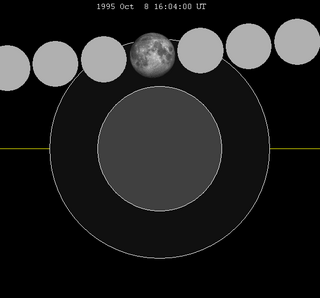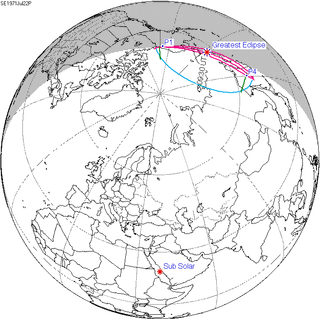
A penumbral lunar eclipse took place on Saturday, August 8, 1998, the second of three lunar eclipses that year.

A penumbral lunar eclipse took place on Saturday, August 8, 1998, the second of three lunar eclipses that year.
| Lunar eclipse series sets from 1998–2002 | ||||||||
|---|---|---|---|---|---|---|---|---|
| Descending node | Ascending node | |||||||
| Saros | Date Viewing | Type Chart | Gamma | Saros | Date Viewing | Type Chart | Gamma | |
| 109 | 1998 Aug 08  | penumbral | 1.4876 | 114 | 1999 Jan 31  | penumbral | −1.0190 | |
| 119 | 1999 Jul 28  | partial | 0.7863 | 124 | 2000 Jan 21  | total | −0.2957 | |
| 129 | 2000 Jul 16  | total | 0.0302 | 134 | 2001 Jan 09  | total | 0.3720 | |
| 139 | 2001 Jul 05  | partial | −0.7287 | 144 | 2001 Dec 30  | penumbral | 1.0732 | |
| 149 | 2002 Jun 24  | penumbral | −1.4440 | |||||
| Last set | 1998 Sep 06 | Last set | 1998 Mar 13 | |||||
| Next set | 2002 May 26 | Next set | 2002 Nov 20 | |||||
According to some sources, this lunar eclipse was the final member of Saros series 109. According to other sources, the next event in the series occurred on August 18, 2016. The previous occurrence was on July 27, 1980.

A penumbral lunar eclipse took place on 6 August 2009, the third of four lunar eclipses in 2009. The moon's small entry into the Earth's penumbral shadow produced an extremely subtle dimming of the moon's southern edge, difficult to observe visually.

A penumbral lunar eclipse took place on 24–25 May 2013, the second of three lunar eclipses in 2013. It was visually imperceptible due to the small entry into the penumbral shadow.

A penumbral lunar eclipse took place on Sunday, January 31, 1999, the first of two lunar eclipses in 1999.

A penumbral lunar eclipse took place on Sunday, September 6, 1998, the last of three lunar eclipses in 1998.

A penumbral lunar eclipse took place on Friday, March 13, 1998, the first of three lunar eclipses in 1998.
A penumbral lunar eclipse took place on 23 March 2016, the first of three lunar eclipses in 2016. The Moon was just 2.1 days before apogee, making it very small, so this was a "Micromoon" penumbral lunar eclipse.

A penumbral lunar eclipse took place on 16 September 2016, the last of three lunar eclipses in 2016.

A penumbral lunar eclipse took place on Thursday, 18 August 2016. It was the second of three lunar eclipses in 2016. This was 3.7 days before the Moon reached perigee. There are multiple ways to determine the boundaries of Earth's shadow, so this was a miss according to some sources. The HM National Almanac Office's online canon of eclipses lists this event as the last eclipse on Saros Series 109, while NASA lists August 8, 1998 as the last eclipse of the series, and has this event missing the shadow.

A penumbral lunar eclipse took place at the Moon's ascending node on 11 February 2017, the first of two lunar eclipses in 2017. It was not quite a total penumbral lunar eclipse. It occurred the same day as comet 45P/Honda–Mrkos–Pajdušáková made a close approach to Earth. It also occurred on the Lantern Festival, the first since 9 February 2009. Occurring only 4.4 days after perigee, the moon's apparent diameter was larger.

A penumbral lunar eclipse took place on Sunday, October 8, 1995, the second of two lunar eclipses in 1995, the first was a partial lunar eclipse on Saturday, April 15.
A penumbral lunar eclipse took place on Thursday, March 3, 1988, the first of two lunar eclipses in 1988, the second being on August 27, 1988. Earlier sources compute this as a 0.3% partial eclipse lasting under 14 minutes, and newest calculations list it as a penumbral eclipse that never enters the umbral shadow. In a rare total penumbral eclipse, the entire Moon was partially shaded by the Earth, and the shading across the Moon should have been quite visible at maximum eclipse. The penumbral phase lasted for 4 hours, 53 minutes and 50.6 seconds in all, though for most of it, the eclipse was extremely difficult or impossible to see. The Moon was 2.2 days after apogee, making it 6.1% smaller than average.

A penumbral lunar eclipse took place on Friday, July 26, 1991, the third of four lunar eclipses in 1991. This was the 2nd member of Lunar Saros 148. The previous event was on 15 July 1973, and the 1st eclipse of the series. The next event was on 6 August 2009.

A penumbral lunar eclipse took place on Wednesday, January 30, 1991, the first of four lunar eclipses in 1991.
A penumbral lunar eclipse took place on Tuesday, May 15, 1984, the first of three lunar eclipses in 1984. This was a deep penumbral eclipse, with the southern limb of the Moon close to the Earth's shadow.
A penumbral lunar eclipse took place on Tuesday, January 20, 1981, the first of two lunar eclipses in 1981. In a rare total penumbral eclipse, the entire Moon was partially shaded by the Earth, and the shading across the Moon should have been quite visible at maximum eclipse. The penumbral phase lasted for 4 hours and 24 minutes in all, though for most of it, the eclipse was extremely difficult or impossible to see. The moon's apparent diameter was larger because the eclipse occurred 5.2 days after perigee.
A penumbral lunar eclipse took place on Sunday, July 27, 1980, the second of three penumbral lunar eclipses in 1980. This very subtle penumbral eclipse was essentially invisible to the naked eye; though it lasted 2 hours, 17 minutes and 36.3 seconds, just 25.354% of the Moon's disc was in partial shadow. The moon passed in the northern edge of the Earth's penumbral shadow, and was the 70th lunar eclipse of Saros cycle 109.

A penumbral lunar eclipse will take place on 18 July 2027. The Moon will barely clip the edge of the Earth's penumbral shadow, and the eclipse will be impossible to see in practice. The event is listed as a miss by some sources.

A partial solar eclipse occurred on July 22, 1971. This was the 70th and final solar eclipse from Solar Saros 116.

Saros cycle series 130 for lunar eclipses occurs at the moon's ascending node, repeats every 18 years 11+1/3 days. The 130th lunar saros is associated with Solar Saros 137.

Saros cycle series 127 for lunar eclipses occurs at the moon's descending node, repeats every 18 years 11 and 1/3 days. It contains 72 events. Solar saros 134 interleaves with this lunar saros with an event occurring every 9 years 5 days alternating between each saros series. It consisted with 10 penumbral eclipses, 21 partial eclipses, 11 total eclipses, 21 partial eclipses, and ends with 8 penumbral eclipses.